An Inside Story from 5th World Nomad Games in Kazakhstan
An Inside Story from 5th World Nomad Games in Kazakhstan
The World Nomad Games, often referred to as the 'Olympics of Central Asia' is a global celebration of nomadic traditions, showcasing ethnic sports, cultural performances, grand opening and closing ceremonies, and craftsmanship passed down through generations. More than just a competition, it's a vibrant platform for preserving heritage, fostering international unity, and immersing visitors in the rich, time-honoured customs of nomadic civilisations.
In September 2024, as Kazakhstan hosted the Games, our Product & Travel Specialist, Susanne Muskita, led a small group tour to experience the exhilaration and cultural tapestry of the traditional Games. After 15 unforgettable days, the group returned with extraordinary experiences to share with you.
Read this first-hand diary from Kazakhstan written by Anne Vaughan, one of the travellers on this tour, where she delves into everything she experienced with her friend, also called Anne. From exploring Aktau's local culture, rich heritage and traditional sports of the Nomadic Games, read on to discover the highlights of their journey.
(2).jpg)
Susanne Muskita
Product & Travel Specialist
"Anne and I became fascinated by Nomad Games after a demonstration at one of our yurt camps in Kyrgyzstan in 2019 and even toyed with going to Turkey in 2020 where the World Nomad Games were due to be held but that didn’t happen because of COVID.
They were actually held in 2022 and as they take place every two years, in 2024 they were held in Astana - the capital of Kazakhstan. Last year we spent only three days in Kazakhstan and wanted to see more, so when the opportunity arose to experience in again with Regent, we just had to go! It was a fabulous, varied trip that led us from the craggy mountain beauty and diverse cultural heritage of Almaty to the excitement of the Nomad Games to end the trip in style. We had four nights in each of Aktau, Almaty and Astana with one night on a train which was bliss after our usual one-and two-night stays!"
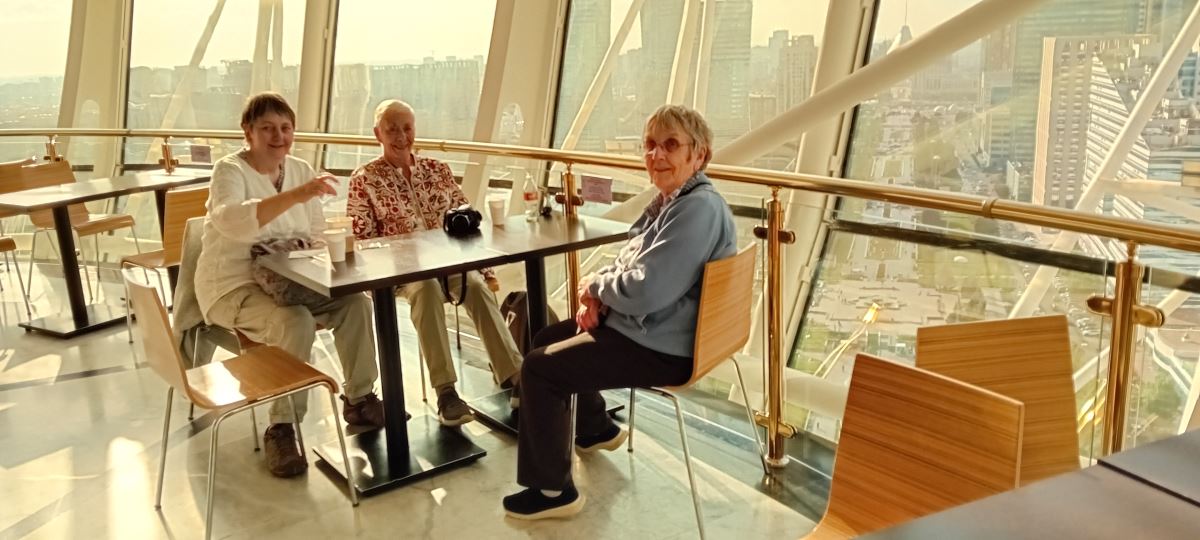 Three Regent clients enjoying the ultimate Kazakhstan trip, including Anne and her friend, Anne
Three Regent clients enjoying the ultimate Kazakhstan trip, including Anne and her friend, Anne
Day 1: Sunday 1 September - Arrival in Kazakhstan
I booked a local taxi with Chris to Heathrow, as travelling by train can be quite challenging, especially with a large suitcase. At the airport, I met Anne, and we flew with Air Astana to Aktau, a city on the Caspian Sea in western Kazakhstan, known for its Soviet-era architecture.
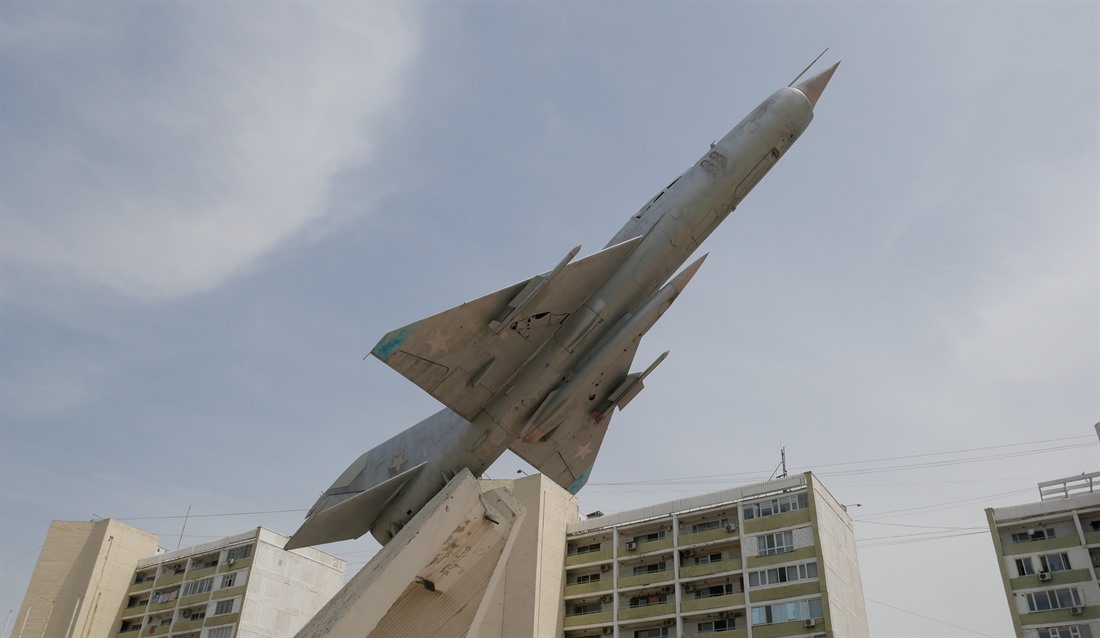 Aktau - MiG Fighter Plane
Aktau - MiG Fighter Plane
Day 2: Monday 2 September - first impressions of Aktau
Aktau was a fascinating city to explore! The districts are uniquely numbered in order of construction, often featuring murals of dignitaries, while local car plates end in '12,' distinguishing the area. Despite its modest size, Aktau boasts an international airport and an excellent hotel - the best of our trip - with freshly brewed coffee, omelettes, and exceptional service.
We arrived at dawn, rested briefly, and enjoyed breakfast with our wonderful tour manager, Susanne. Outside stood a striking MiG fighter jet monument, and nearby, a glowing WWII memorial with an eternal flame and five panels depicting sorrowful scenes for the years 1941 to 1945. Strolling the seafront, we admired statues, Nomad Games plaques, and even dipped our feet into the Caspian Sea.
After lunch and a currency exchange adventure, some relaxed while the rest visited the Caspian Riviera Hotel’s sturgeon breeding aquarium—possibly the only museum of its kind! We also experienced the warm Kazakhstan with a delicious dinner - it was a feast of beautifully presented salads, meats, dumplings, and desserts. While alcohol was scarce, the local berry juice was delicious.
Beyond Aktau, the Mangystau region unfolded like a geologist’s dream - its landscapes among the most extraordinary in the world!
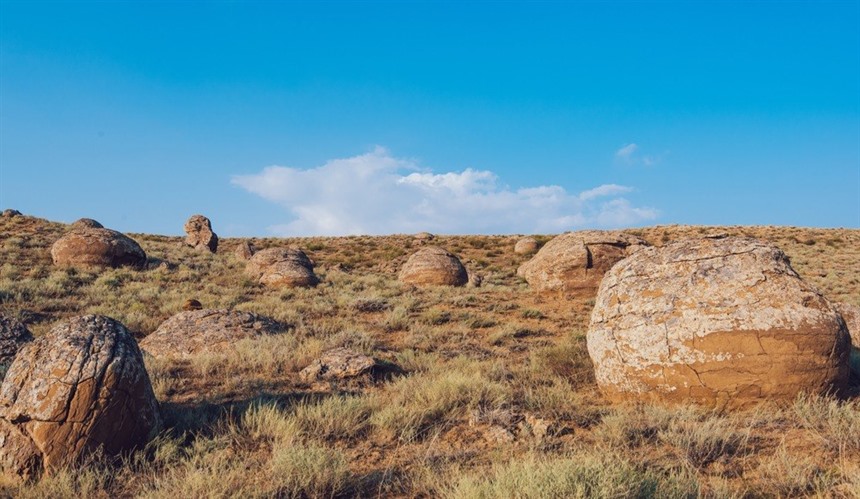 Valley of the Balls
Valley of the Balls
Day 3: Tuesday 3 September - off-road adventures: canyons, camels, and ancient mysteries
The next day, we all headed north in six four-wheel-drives for an off-road adventure. Our first stop was Sultan Epe, an underground mosque with nine rooms, where pilgrims drew water from a holy spring. Before lunch, we admired Kapamsay Canyon. Four kilometres long and 70 metres deep, its floor was scattered with giant boulders and dazzling white strata.
Lunch was in a remote yurt, with distant views of the Caspian Sea. We then passed camel-dotted mountains to Torysh, the Valley of Balls, it's strange rock formations steeped in legend. After seeing Sherkala (Lion Mountain) and the Red Fortress of Kyzyikala, we returned to Aktau - ending the day with a gin and tonic!
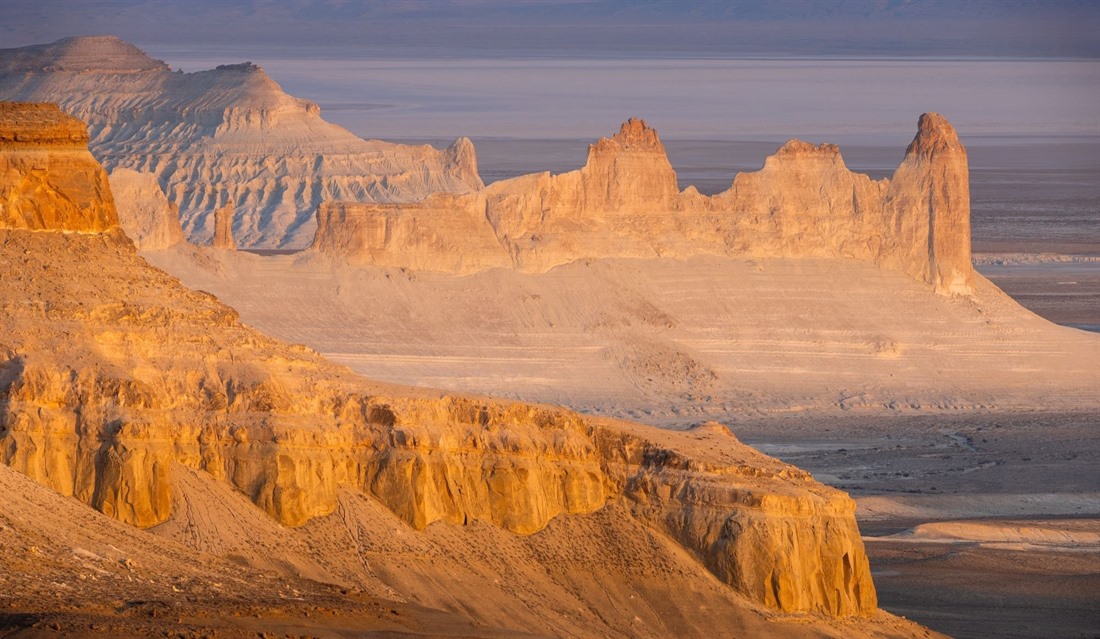 Bozjyra
Bozjyra
Day 4: Wednesday 4 September - from Tiramisu Mountains to Bozjyra
The day was expected to be long, but with a new tarmac road to Bozjyra, it was straightforward. We stopped to view an area 132 metres below sea level and passed a vast oil field with hundreds of nodding donkeys, which we photographed on the way back. Our first off-road stop was the stunning Kyzylkup Mountains, known as the Tiramisu Mountains for their creamy and red strata.
Nearby, Mount Bokty stood alone, 165 metres high, depicted on the 1000 tenge note. After a tasty roadside picnic, evoking Sudan memories for Anne and me, we ventured off-road to Bozjyra on the Ustyurt Plateau - a breathtaking landscape shaped by ancient oceans, where fossilised shells and shark teeth remain. The striking white and brown rock formations, known as ‘statues,’ added to the magic. We returned to Aktau for dinner in a soulless hotel - another gin and tonic!
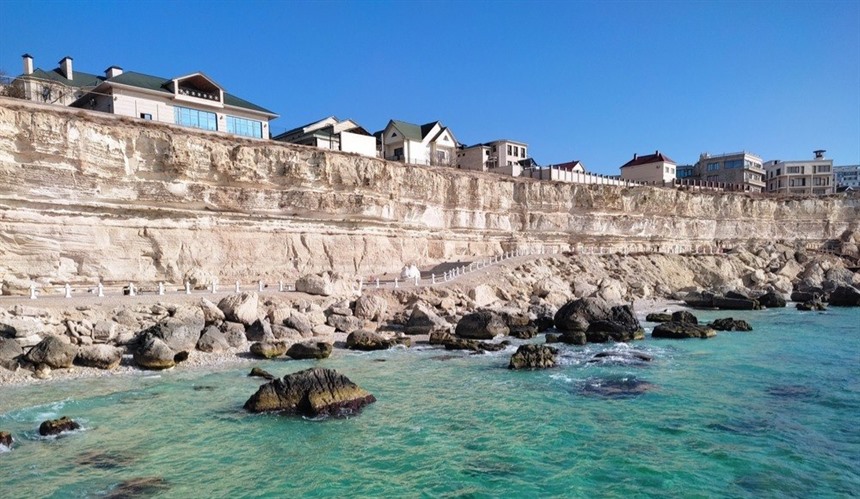 Aktau, Caspian Sea
Aktau, Caspian Sea
Day 5: Thursday 5 September - exploring Aktau: culture, coastlines, and colourful cliffs
Our final day in Aktau began at the Cultural Centre of Abish Kekilbaev, a highly revered Kazakh writer, housed in a beautiful building with his statue outside. Personally, I would have preferred the Museum of History and Folklore. We visited the main mosque before enjoying a delicious Turkish lunch.
Next, we saw the statue of the sailing boat Aktau, symbolising the city, and the quirky red-and-white checkered Melovoi lighthouse, built into a Soviet-era apartment block. In the afternoon, we sailed the Caspian on catamarans. After dinner, some of the group visited the Rocks, where the cliffs along the promenade glow with colourful lights at night.
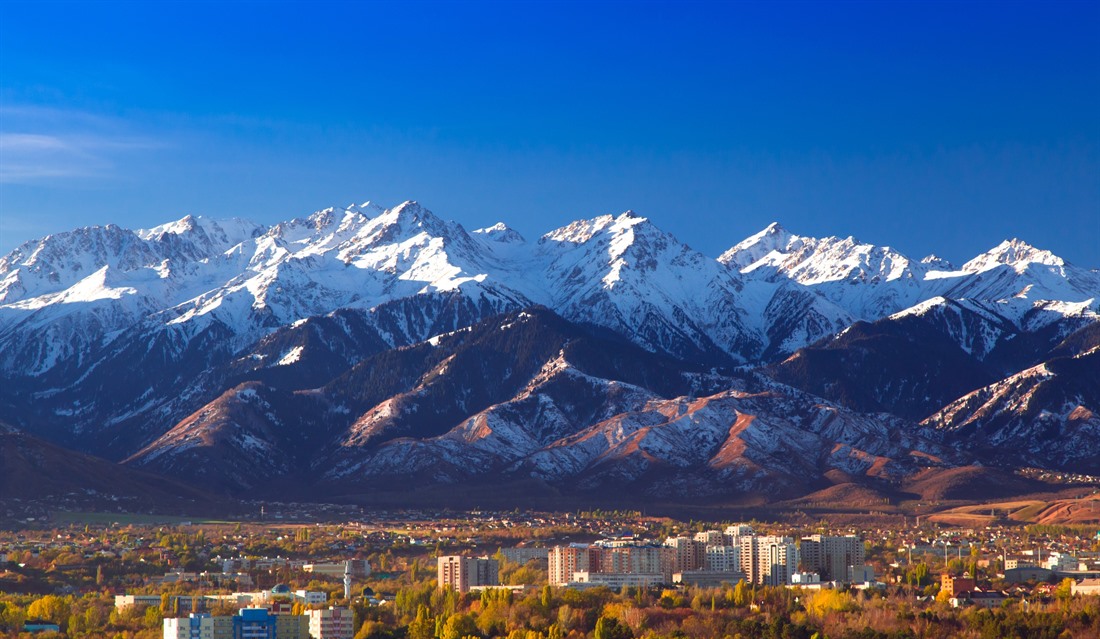 Almaty city scape
Almaty city scape
Day 6: Friday 6 September - arrival in Almaty
We flew late to Almaty, near Kyrgyzstan, with a delayed arrival that led to breakfast and a nap until noon. Susanne had arranged extras, including a visit to a beautiful bath complex for massages. I had a back massage, then enjoyed a Moroccan tea and citrus fruits with mint at lunch. We took taxis to get around and attended a wine tasting with snacks from the Assa Valley.
Afterward, our taxi driver had a bit of trouble finding the hotel, but eventually got us there. Both this hotel and the one in Astana offered great rooms, though occasional service delays due to staff shortages caused some minor inconvenience. Our guide, Manas, was a real gem - knowledgeable, personable, and charming.
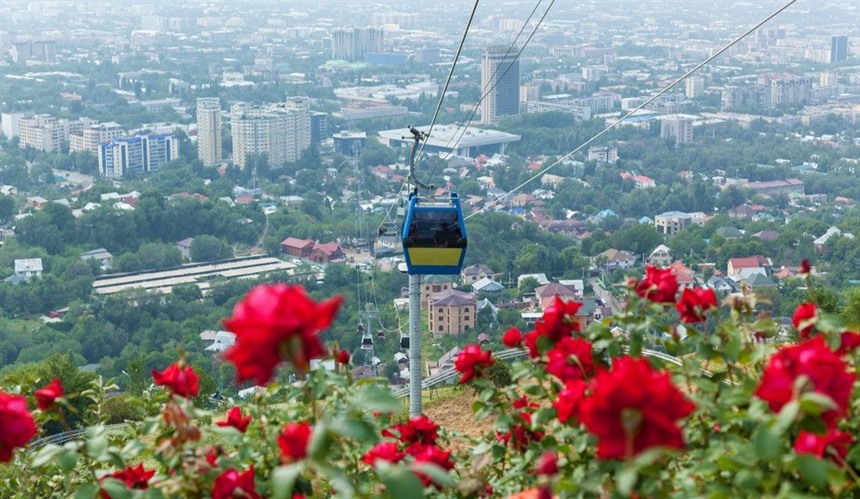 Zenkov Cathedral, Almaty, Kazakhstan
Zenkov Cathedral, Almaty, Kazakhstan
Day 7: Saturday 7 September - Almaty's mountains, markets, and memorable moments
The next day, we started early with a visit to Medeo Gorge, home to the world's highest skating rink, but it was too early in the season to go inside. We then took a steep cable car to Shymbulak ski resort and two shorter ones to the Altai mountains in the Tien Shan range, which stretches all the way to Urumqi in China. The views were stunning, and at the top, we enjoyed fresh snow.
On the way down, we stopped for hot chocolate. After a lunch of delicious spaghetti Bolognese, we explored Almaty’s pedestrian streets, visited the Green Bazaar, and stopped by a chocolate shop. We also toured the Panfilov Park memorial and visited the Zenkov Cathedral, where a service was underway. We finished the day at a Georgian restaurant with Fran, a fellow traveller. Susanne booked it for us, but it wasn’t the one Fran had seen locally the night before. A very kind Uzbek helped us find it and after a good meal we took a taxi back to the hotel with a much nicer driver!
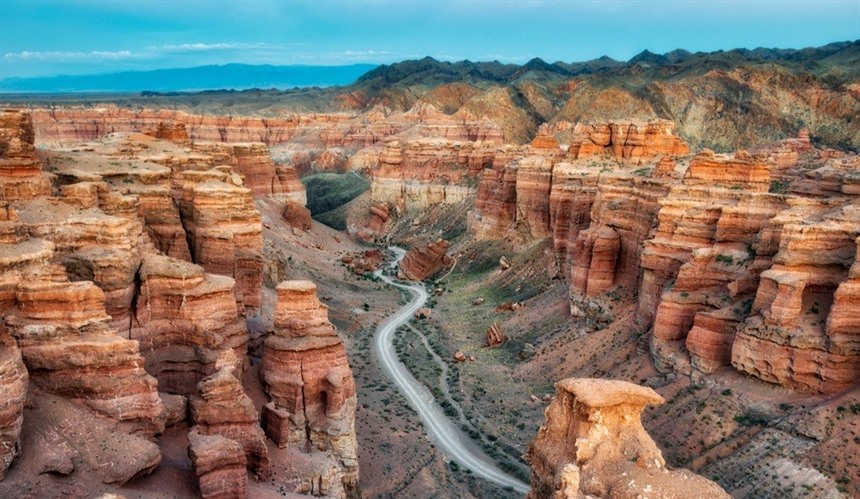 Susanne at Charyn Canyon
Susanne at Charyn Canyon
Day 8: Sunday 8 September - exploring the majestic Charyn Canyon and a 'Fawlty Towers' dinner
We drove to Charyn Canyon, south of Almaty, for the second time - this Kazakhstan gem is often called the Grand Canyon. We arrived just in time for lunch at the heritage centre, skipping the walk along the canyon’s rim.
Afterward, we descended to the Valley of the Castles, a stunning sandstone landscape with incredible shapes formed by centuries of erosion. The weather was mild, and shaded shelters along the way offered historical facts. At the bottom, we saw the Charyn River and trees (not the famous Sogdian Ash). After a truck ride back up, we climbed the steps, then enjoyed a Fawlty Towers-style dinner with Fran at the hotel, complete with a dozy waiter and a wine mix-up (three glasses of red - only two Shiraz available, no French wines, so Fran ended up with Portuguese!)
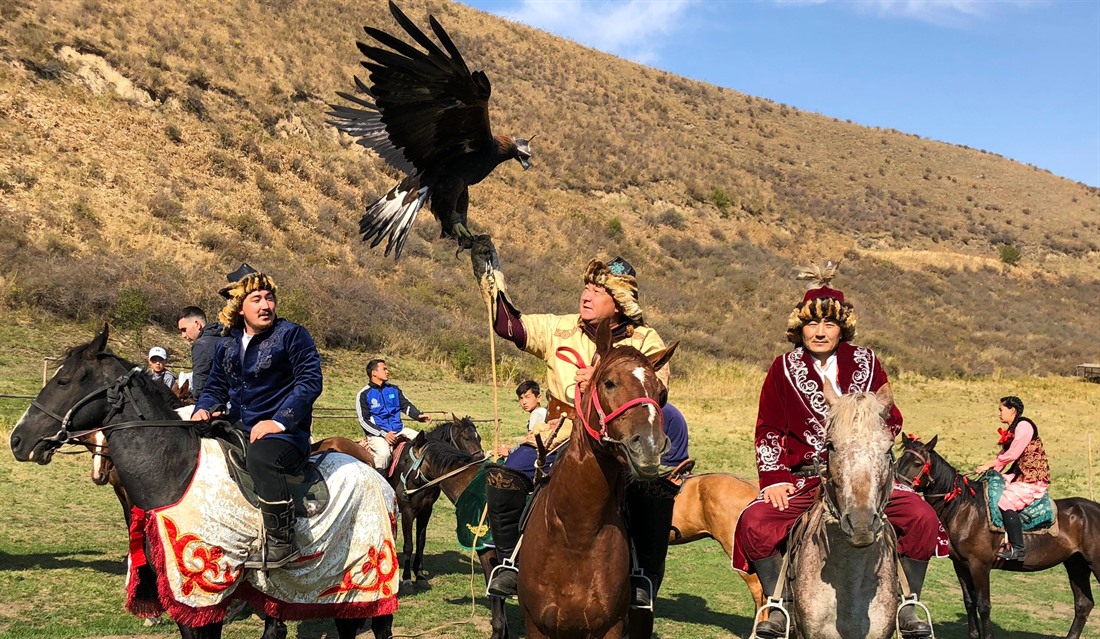 Koktobe hill cable car
Koktobe hill cable car
Day 9: Monday 9 September - Kok Tobe
We spent a fascinating day at Huns Ethno village learning about Kazakh Nomadic culture, including making ‘buarsak’ bread and constructing a yurt. We watched nomad horse events, enjoyed an authentic lunch, and some tried traditional archery.
In the afternoon, we took the cable car up Kok Tobe hill for stunning views, visited the small zoo, and saw the Beatles statue. We finished with Moroccan tea before heading down and finding a nice restaurant near the hotel. Although we didn't see the grand opening ceremony, we certainly had an exciting day filled with tradition and cultural heritage.
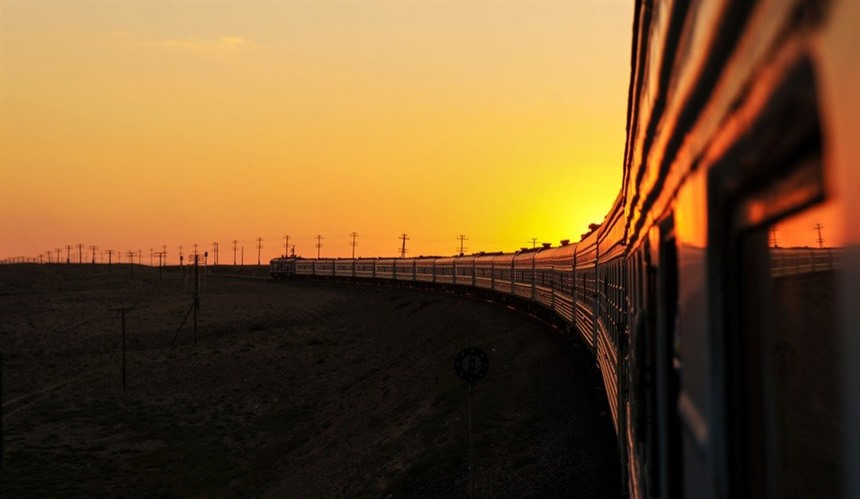 Train journey to Astana
Train journey to Astana
Day 10: Tuesday 10 September - train journey to Astana: a scenic adventure with sleepless nights
The next morning, we shopped for supper at the supermarket – Brie, onion bread, and Australian red – before lunch in Gorky Park and heading to the train station. We had two-berth compartments, with limited space for our cases, so we packed small rucksacks for the overnight trip. One case fit under the bunks, and the other was used for extra storage. I had the bottom bunk, while Anne climbed up to the top. We made a 20-minute stop at Shu, where locals sold wares like apples and dried fish.
Afterward, we had tea in the restaurant car with Susanne and Jean. Though a couple flew to Astana, the rest of us, including 10 women and two couples, enjoyed the experience. No one slept well, but at least we were lying down, unlike my student days on sitting-up trains!
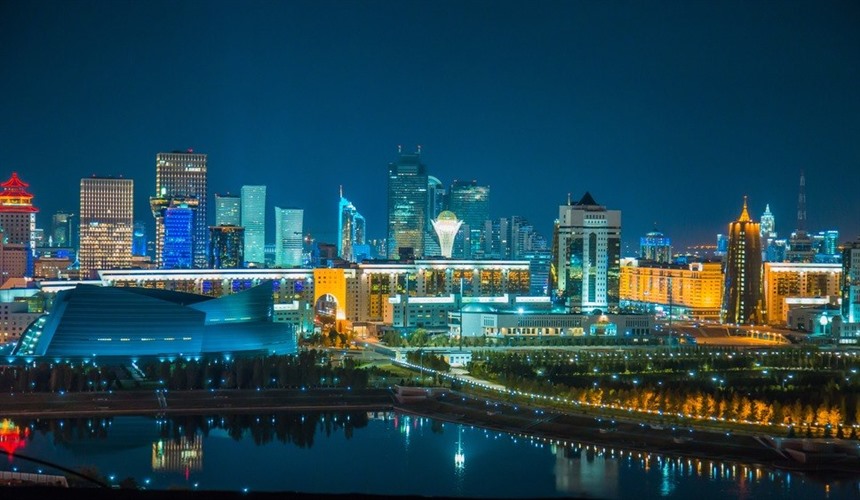 Astana horse back archery
Astana horse back archery
Day 11: Wednesday 11 September - let the games begin and quirky dining adventures
We arrived in Astana around 7:00am, had breakfast at the hotel, and then headed to the Games, set on the city’s outskirts with yurts, shops, and food stalls. We watched horseback archery, where riders hit three targets. Participants from around the world, including Cameroon, competed, with Kyrgyzstan and Kazakhstan dominating the medals.
After a Georgian lunch, we returned for the strongman event, featuring feats like lifting “sheep” and pulling heavy carts. Jean noted the world’s strongest man, a Scot, wasn’t there. Dinner was at a quirky restaurant, where I ordered Bolognese but got creamed chicken - it was really quite tasty!
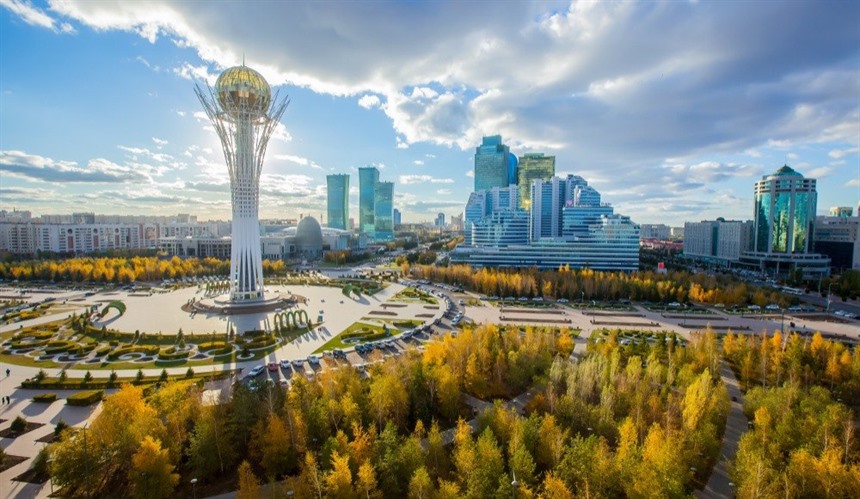 Astana city
Astana city
Day 12: Thursday 12 September - Astana's Nomad Games
On the second day in Astana, we visited the magnificent Space Centre with its three rockets outside before heading to the Games. The first Nomad Game was known as the 'headless goat polo' - two teams of seven try to score by dumping the 'goat' into a ring. Horse riders can swap in and out like in ice hockey, and there’s a scrum for control.
We watched Russia thrash Turkey 7-1 for the bronze, then an exciting final between Kazakhstan and Kyrgyzstan. Surrounded by Kyrgyz supporters, Kazakhstan made a comeback from 3-1 down to tie 4-4, winning 5-4 in extra time! After lunch, we went to the horseback wrestling (or 'er enish') and had excellent seats, perfect for watching warriors in traditional clothes fighting. Dinner at Fawlty Towers followed.
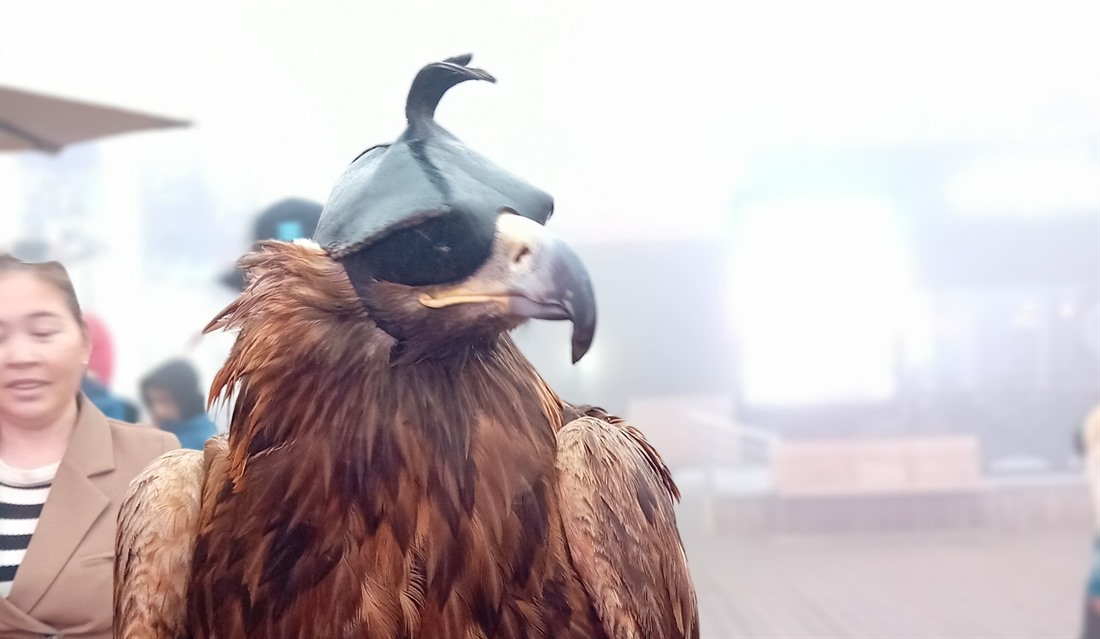 Eagle at the Nomad Games
Eagle at the Nomad Games
Day 13: Friday 13 September - The finale of the World Nomad Games
On our final day at the Games, we watched them host hunting competitions, thrilling purse picking events, and the closing ceremonies. In purse picking, riders raced to grab as many purses as they could. The eagles and falcons were stunning, though I couldn't quite follow the action. Mike, a fellow traveller, filmed a great video for us!
After lunch, we toured Astana, a city built to showcase Kazakhstan's independence. Designed by a Japanese architect with global talent, its stunning buildings include a glass shopping centre and Norman Foster’s pyramid-shaped Palace of Peace. We walked past large horse statues, fountains, and colourful flower beds, ending at the giant independence tower. We visited the Presidential Palace and the Astana Grand Mosque before dinner at a Georgian restaurant, where ordering online seemed a bit odd!
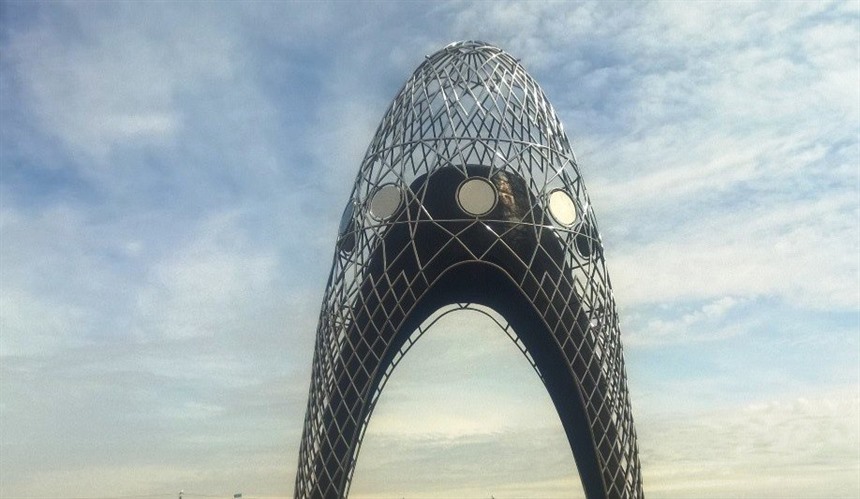 Alzhir Memorial Complex
Alzhir Memorial Complex
Day 14: Saturday 14 September - Alzhir Memorial
On our final day, we visited the Alzhir Memorial Complex, a significant site dedicated to the women who were imprisoned due to their husbands' dissident activities. The museum, located a few kilometres from the original site, invites reflection on the past. At the entrance stands the 18-metre Arch of Sorrow monument, symbolising a woman mourning her family. Inside, visitors can view a watchtower, statues for contemplation, and a replica of the hut where the women lived. A memorial wall lists the names of many, including ethnic Koreans.
Afterward, we enjoyed lunch in Astana amidst ongoing development and then visited the Pyramid, with its stunning blue dove-covered windows and a garden at the top. Our final stop was the National Museum, where we saw the magnificent Red Saka Warrior before concluding the day with a farewell dinner and a night tour of the city.
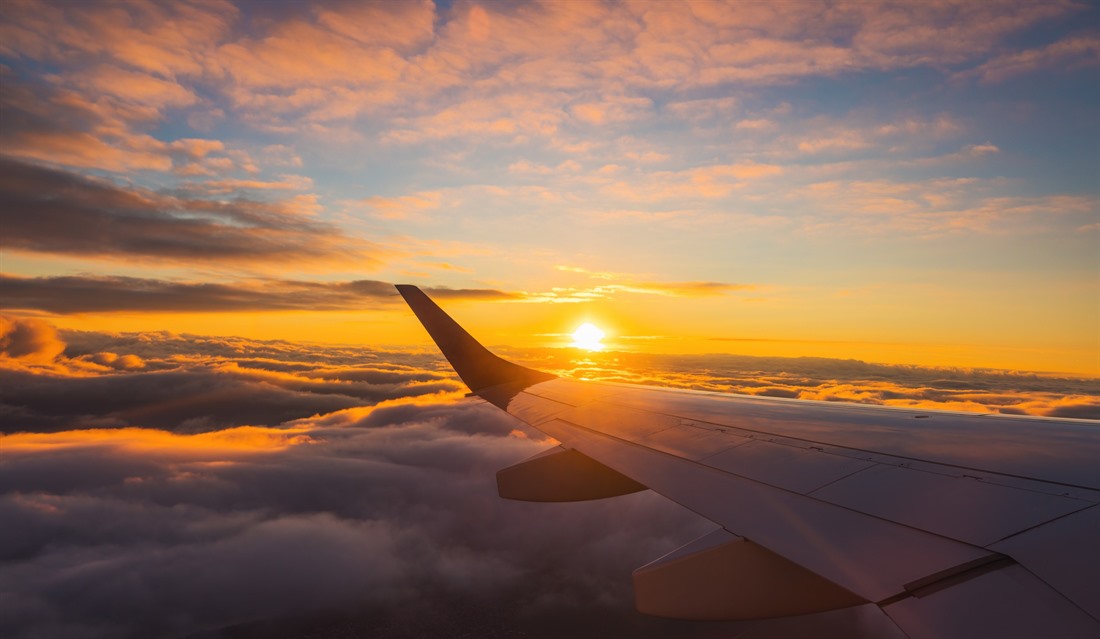 Plane journey home
Plane journey home
Day 15: Sunday 15 September - journeying home to the UK
We left the hotel at 6am for the flight to Aktau. The London flight was an hour late, but I was met by Chris and arrived back in Knutsford by 10:00pm. Anne took the train to her new home in Telford. What an amazing holiday—Kazakhstan exceeded all expectations!
Discover more of Regent's unique holidays
There's nothing quite like going beyond the ordinary and experiencing the unparalleled adventures the world has to offer. See below some of our travel blogs that showcase some of the spectacular journeys our Regent Travel Specialists have embarked on:
- Oman Desert Tours: 10 Things to See & Do
- Kazakhstan Travel Guide: Is Kazakhstan Worth Visiting?
- Unveiling the Hidden Charms of Kazakhstan's Mangystau Province
- A Photo Journal of Uzbekistan & Tajikistan
Your Kazakhstan Holiday
Find your next Kazakhstan holiday with our hand-picked tours perfect for you below, whether it's tailor-made, a group tour or a railway holiday:
- Culture & Nature of Kazakhstan Group Tour | Regent Holidays
- Essential Kazakhstan | Regent Holidays Tour
- 10-Day Kazakhstan Walking Tour from £3070 | Explore Almaty & Nature
- Treasures of Kazakhstan | Book Kazakhstan Tours
- Discover Kazakhstan | Book Kazakhstan Tours
Want to experience the spectacular World Nomad Games?
If you’re inspired by this incredible journey, why not explore Kazakhstan and the Nomad Games yourself? Check out our upcoming travel guides and events for a deeper dive into this fascinating destination.
Looking ahead, don’t miss the 2026 World Nomad Games in Kyrgyzstan – an opportunity to experience the culture, sports, and adventure of the nomadic world like never before! Stay tuned for more details and plan your next adventure today!